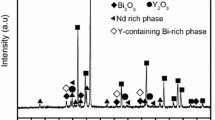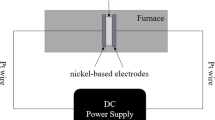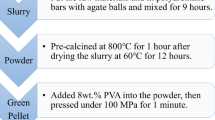Abstract
The method applied in this study to develop conventional sintered varistors is based on liquid synthesis, The percentage of raw materials used is as follows: 98 mol% ZnO, 0.5 mol% Bi2O3, 0.5 mol% Sb2O3, 0.5 mol% Co2O3, 0.5 mol% MnO2 was sintered in a sintering temperature cycle from 900 to 1200 °C with different sintering times up to 120 min, the highest densification rates, 98.56%, are obtained at the temperature of 1200 °C, the grain sizes are greater than 1.61 µm for the temperature of 900 °C and increase little from one sample to another for all sintering temperatures. The presence of a spinel phase Zn7Sb2O12 as well as Bi2O3. The nonlinearity coefficient was high for the majority of sintered varistors at temperatures of 1000 °C and 1100 °C such that α > 35. The trigger field values (Ea) are nearly identical for all sintering temperatures, The electric fields for sintering at 1000 °C are a little high at about 373 V.mm−1 as a maximum value, 263 V.mm−1 for sintering at 1100 °C and 258 V. mm−1 for sintering at 1200 °C and we can also note that the density value of the leakage current is very low.











Similar content being viewed by others
Data availability
The data presented in this study are available on request from the corresponding author.
References
J. Ren, G. Jiang, Z. Wang et al., Highly, thermoconductive and mechanically robust boron nitride/aramid composite dielectric films from non-covalent interfacial engineering. Adv. Compos. Hybrid Mater. 7, 5 (2024). https://doi.org/10.1007/s42114-023-00816-z
P. Pal, S.K. Das, D. Dey, K. Chakrabarti, Photovoltaic integrated solar induction heater using voltage source inverter. ES Energy Environ. 16, 26–29 (2022). https://doi.org/10.30919/esee8c686
T. Kwon, S.H. Lee, J.H. Kim et al., Polypropylene nanocomposites doped with carbon nanohorns for high-voltage power cable insulation applications. Adv. Compos. Hybrid Mater. 6, 167 (2023). https://doi.org/10.1007/s42114-023-00746-w
R. Dai, C. Ding, X. Li et al., Molecular single crystals induce chain alignment in a semiconducting polymer. Adv. Compos. Hybrid Mater. 6, 35 (2023). https://doi.org/10.1007/s42114-022-00611-2
R.S. Jawad, H. Abid, Fault detection and classification for voltage source converter-high voltage systems by using different swarm optimization algorithms-based neural network. Eng. Sci. 23, 884 (2023). https://doi.org/10.30919/es884
X.U. Dong, S.H.I. Xiao-feng, CHENG Xiao-nong, et al, Microstructure and Electrical properties of Lu2O3-doped ZnO-Bi2O3-based varistor ceramics. Transact. Nonferrous Metal. Soc. China 20(12), 2303–2308 (2010). https://doi.org/10.1016/S1003-6326(10)60645-0
I.V. Markevich, T.R. Stara, I.P. Vorona et al., Role of ZnMn2O4 phase in formation of varistor characteristics in ZnO:Mn ceramics. Semicond. Phys. Quantum Electron. Optoelectron. 26(3), 255–259 (2023). https://doi.org/10.15407/spqeo26.03.255
Xu. Dong, K. He, L. Jiao et al., Microstructure and electrical properties of ZrO2-doped ZnO varistor ceramics. J. Mater. Sci. Mater. Electron. 27(1), 767–771 (2016). https://doi.org/10.1007/s10854-015-3814-5
E. Olsson, L.K. Falk, G.L. Dunlop et al., The microstructure of a ZnO varistor material. J. Mater. Sci. 20, 4091–4098 (1985). https://doi.org/10.1007/BF00552403
P. Xie, Z. Wang, Wu. Kangning, Evolution of intrinsic and extrinsic electron traps at grain boundary during sintering ZnO based varistor ceramics. Materials 15(3), 1098 (2022). https://doi.org/10.3390/ma15031098
Y.-W. Hong, Y.-J. Lee, S.-K. Kim et al., Admittance spectroscopy and electrical properties of Co3O4-doped ZnO. Electron. Mater. Lett. 10(5), 903–906 (2014). https://doi.org/10.1007/s13391-014-3331-3
H.H. Hng, K.M. Knowles, Microstructure and current-voltage characteristics of praseodymium-doped zinc oxide varistors containing MnO2, Sb2O3 and Co3O4. J. Mater. Sci. 37(6), 1143–1154 (2002). https://doi.org/10.1023/A:1014359204034
M. Peiteado, J.F. Fernandez, A.C. Caballero, Varistors based in the ZnO–Bi2O3 system: microstructure control and properties. J. Eur. Ceram. Soc. 27(13), 3867–3872 (2007). https://doi.org/10.1016/j.jeurceramsoc.2007.02.046
L. Liu, P. Chen, X. Zhang et al., Solution synthesis of two-dimensional zinc oxide (ZnO)/molybdenum disulfide (MoS2) heterostructure through reactive templating for enhanced visible-light degradation of rhodamine B. Adv. Compos. Hybrid Mater. 6, 223 (2023). https://doi.org/10.1007/s42114-023-00780-8
R. Ma, B. Cui, D. Hu et al., Enhanced energy storage of lead-free mixed oxide core double-shell barium strontium zirconate titanate@magnesium aluminate@zinc oxide–boron trioxide–silica ceramic nanocomposites. Adv. Compos. Hybrid Mater. 5, 1477–1489 (2022). https://doi.org/10.1007/s42114-022-00509-z
J. Wang, C. Yang, L. Zhang et al., Monodispersed zinc oxide nanoparticles as multifunctional additives for polycarbonate thermoplastic with high transparency and excellent comprehensive performance. Adv. Compos. Hybrid Mater. 5, 2936–2947 (2022). https://doi.org/10.1007/s42114-022-00512-4
V. Murugadoss, D.Y. Kang, W.J. Lee et al., Fluorine-induced surface modification to obtain stable and low energy loss zinc oxide/perovskite interface for photovoltaic application. Adv. Compos. Hybrid Mater. 5, 1385–1395 (2022). https://doi.org/10.1007/s42114-022-00498-z
P.L. Meena, K. Poswal, A.K. Surela et al., Synthesis of graphitic carbon nitride/zinc oxide (g-C3N4/ZnO) hybrid nanostructures and investigation of the effect of ZnO on the photodegradation activity of g-C3N4 against the brilliant cresyl blue (BCB) dye under visible light irradiation. Adv. Compos. Hybrid Mater. 6, 16 (2023). https://doi.org/10.1007/s42114-022-00577-1
A.S. Desai, V. Dabir, A. Ashok, Wu. Zijian, H.M. Pathan, Z. Guo, N. Bhagat, Microbicidal study of zinc oxide nanocomposites based coir geotextile with image processing. ES Gen. 3, 1101 (2024). https://doi.org/10.30919/esg1101
S.S. Wagh, D.B. Salunkhe, S.P. Patole, S. Jadkar, R.S. Patil, Zinc oxide decorated carbon nanotubes composites for photocatalysis and antifungal application. ES Energy Environ. 21, 945 (2023). https://doi.org/10.30919/esee945
K.S. Shaikh, A.M. Mujawar, A.T. Supekar, P.E. Lokhande, J.L. Gunjakar, H.M. Pathan, Nickel doped zinc oxide/titanium oxide films toward light harvesting. ES Energy Environ. 22, 992 (2023). https://doi.org/10.30919/esee992
E. Savary, S. Marinel, F. Gascoin et al., Peculiar effects of microwave sintering on ZnO based varistors properties. J. Alloys Compd. 509(21), 6163–6169 (2011). https://doi.org/10.1016/j.jallcom.2011.03.048
M.-H. Wang, C. Yao, N.-f Zhang, Degradation characteristics of low-voltage ZnO varistor manufactured by chemical coprecipitation processing. J. Mater. Process. Technol. 202(1), 406–411 (2008). https://doi.org/10.1016/j.jmatprotec.2007.09.033
A.B. Glot, I.A. Skuratovsky, Non-ohmic conduction in tin dioxide based varistor ceramics. Mater. Chem. Phys. 99(1), 487–493 (2006). https://doi.org/10.1016/j.matchemphys.2005.11.028
Q. Xu, Z. Wu, W. Zhao et al., Strategies in the preparation of conductive polyvinyl alcohol hydrogels for applications in flexible strain sensors, flexible supercapacitors, and triboelectric nanogenerator sensors: an overview. Adv. Compos. Hybrid Mater. 6, 203 (2023). https://doi.org/10.1007/s42114-023-00783-5
C. Hou, H. Xie, Y. Qu et al., Rigid-flexible double coating silicon oxide composed of pitch pyrolytic carbon and polyvinyl alcohol/polyethyleneimine/carbon nanotubes as high-performance anode material for lithium-ion battery. Adv. Compos. Hybrid Mater. 6, 143 (2023). https://doi.org/10.1007/s42114-023-00715-3
J. Liu, E. Chen, Y. Wu et al., Silver nanosheets doped polyvinyl alcohol hydrogel piezoresistive bifunctional sensor with a wide range and high resolution for human motion detection. Adv. Compos. Hybrid Mater. 5, 1196–1205 (2022). https://doi.org/10.1007/s42114-022-00472-9
D. Kong, Z.M. El-Bahy, H. Algadi et al., Highly sensitive strain sensors with wide operation range from strong MXene-composited polyvinyl alcohol/sodium carboxymethylcellulose double network hydrogel. Adv. Compos. Hybrid Mater. 5, 1976–1987 (2022). https://doi.org/10.1007/s42114-022-00531-1
J.D. Levine, Theory of varistor electronic properties. Crit. Rev. Solid State Mater. Sci. 5(4), 597–603 (1975). https://doi.org/10.1080/10408437508243517
P. Jiaping Han, A.M.R. MantasSenos, Defect chemistry and electrical characteristics of undoped and Mn-doped ZnO. J. Eur. Ceram. Soc. 22(1), 94–95 (2002). https://doi.org/10.1016/S0955-2219(01)00241-2
S. Marinel, D.H. Choi, R. Heuguet et al., Broadband dielectric characterization of TiO2 ceramics sintered through microwave and conventional processes. Ceram. Int. 39(1), 299–306 (2013). https://doi.org/10.1016/j.ceramint.2012.06.025
J. Wojnarowicz, T. Chudoba, S. Gierlotka, K. Sobczak, W. Lojkowski, Size control of cobalt-doped ZnO nanoparticles obtained in microwave solvothermal synthesis. Crystals 8(4), 179 (2018). https://doi.org/10.3390/cryst8040179
C.-W. Nahm, Sintering effect on varistor properties and degradation behavior of ZVMB varistor ceramics. J. Mater. Sci. Mater. Electron. 28, 17063–17069 (2017). https://doi.org/10.1007/s10854-017-7632-9
G.G. Kaan, T.H. Özkan, Densification and grain growth of SrO-doped ZnO. Ceramics-Silikáty 50, 225–231 (2006)
M. Kumar, M.A.B. Achour, M. Lasgorceix, P. Quadros, R. Mincheva, J.-M. Raquez, A. Leriche, Densification of hydroxyapatite through cold sintering process: role of liquid phase chemistry and physical characteristic of HA powder. Open Ceram. 17, 100566 (2024). https://doi.org/10.1016/j.oceram.2024.100566
C.W. Nahm, The effect of sintering temperature on varistor properties of (Pr Co, Cr, Y, Al)-doped ZnO ceramics. Mater. Lett. 62(29), 4440–4442 (2008). https://doi.org/10.1016/j.matlet.2008.07.042
A. Badev, S. Marinel, R. Heuguet, E. Savary, D. Agrawal, Sintering behavior and non-linear properties of ZnO varistors processed in microwave electric and magnetic fields at 2.45 GHz. Acta Mater. 61, 7849–7858 (2013). https://doi.org/10.1016/j.actamat.2013.09.023
W. Cao, Y. Guo, J. Su et al., Effect of sintering temperature on the microstructural evolution of ZnO varistors. J. Electron. Mater. 52, 1266–1273 (2023). https://doi.org/10.1007/s11664-022-10054-6
T. Li, W. Guo, A. Xie et al., Structural and electrical properties of ZnO–V2O5–TiO2–Co2O3–MnO varistor ceramics with low sintering temperature. J. Mater. Sci. Mater. Electron. 34, 607 (2023). https://doi.org/10.1007/s10854-023-09935-1
Z. Xu, Y. Wei, S. Ma et al., Low breakdown electric field B2O3-doped ZnO–Bi2O3–TiO2–Co2O3–MnO2 varistor ceramics fabricated by low temperature sintering. J. Mater. Sci. Mater. Electron. 34, 342 (2023). https://doi.org/10.1007/s10854-022-09512-y
P. Xie, J. Hu, Influence of sintering temperature and ZrO2 dopants on the microstructure and electrical properties of zinc oxide varistors. IEEE Access 7, 140126–140133 (2019). https://doi.org/10.1109/ACCESS.2019.2941965
F. Cui, Z. Xu, R. Chu, Low temperature sintering ZnO–Bi2O3 based varistor ceramic with low electrical breakdown voltage and high nonlinear coefficient. Ceram. Int. (2020). https://doi.org/10.1016/j.ceramint.2020.09.288
Acknowledgements
I would like to thank all the people who worked in the laboratories of Ferhat Abbes Sétif 1 University as well as the director of the LMCPA laboratory and her team at the University of Valenciennes for their help.
Funding
The authors have not disclosed any funding.
Author information
Authors and Affiliations
Contributions
Faiçal Kharchouche contributed to supervision, conceptualization, methodology and project administration. Faiçal Kharchouche and Samia Latreche contributed to the investigation, data curation, software, validation, resources, writing—original draft, writing—review and editing.
Corresponding author
Ethics declarations
Conflict of interest
The authors declare that they have no conflicts of interest.
Additional information
Publisher's Note
Springer Nature remains neutral with regard to jurisdictional claims in published maps and institutional affiliations.
Rights and permissions
Springer Nature or its licensor (e.g. a society or other partner) holds exclusive rights to this article under a publishing agreement with the author(s) or other rightsholder(s); author self-archiving of the accepted manuscript version of this article is solely governed by the terms of such publishing agreement and applicable law.
About this article
Cite this article
Kharchouche, F., Latreche, S. Elaboration and electrical characterization of ZnO-based varistor ceramics in different sintering temperatures. J Mater Sci: Mater Electron 35, 836 (2024). https://doi.org/10.1007/s10854-024-12602-8
Received:
Accepted:
Published:
DOI: https://doi.org/10.1007/s10854-024-12602-8




